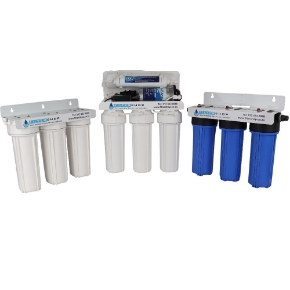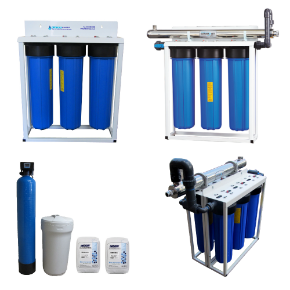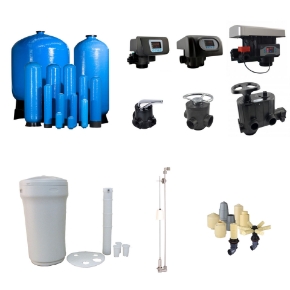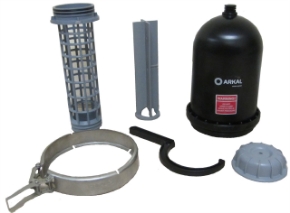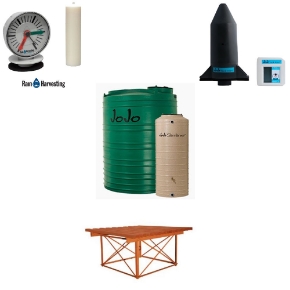Choosing the correct filters for your Borehole with a tank:
This guide is working on the assumption that you are looking for a solution for a house and the system is designed around allowing two showers to run at the same time. If you need a larger solution we can assist you, please email us your situation to [email protected]
- If you know the water has a very high salt or lime content contact us.
- A basic solution like this will not be able to address thing like heavy metals of water-specific problems if you suspect you might have serious problems with the water get the water testes and contact us for a custom solution.
There are a few basic tests that you can do at home to evaluate your water quality, ideally however it is better to get your water tested at a lab: https://filtershop.co.za/en/lab-water-testing
- First, we what you can do is a small test at home to see how much the iron and manganese are potentially in the water as this can make the water dirty after it has been exposed to oxygen.
o We call it the Jik test you will need 2 x clear 5L water bottles and some normal Jik. Then you can fill both 5L bottles 90% full directly from the borehole. After this add 3 Tablespoons of Jik to the one container and nothing to the other. Next, leave both bottles standing still for 24 hours preferably against a white background.
- Get a small pH test kit from a pool shop or hardware and test the pH of your water.
- Fill a large white container or a bath with the borehole water and see if there is any discolouring.
- Place some water in a bottle about half full let it stand for an hour and open it. Mell the air in the bottle for any unpleasant odours.
If at this point you are comfortable with selecting your own solution here is what we can look at:
Before your tank:
Dirt levels:
- If the water stays clear even after the Jik test, you don’t need any sediment filters before the tank.
- If you have slight discolouring but the water is still relatively clean you can fit a 20 Micron Washable Disc Filter before the tank to catch most of the visible dirt: https://filtershop.co.za/en/disc-filters
- If the water is quite dirty you can look at a 75L or 100L AFM Glass Media Filter as it has much bigger dirt carrying capacity: https://filtershop.co.za/en/afm-glass-media-filter-vessels
- If your Jik test showed brown water only after adding Jik then you will need a filter like this after the tank to catch the oxidised materials.
If you found that your pH is lower than 7 or higher than 7.8:
- A low pH will result in the water being corrosive and thus damaging the pipes and infrastructure in your house, to increase the pH you can install a pH correction vessel before your tank: https://filtershop.co.za/en/ph-correction-calcite-vessel
- For a slightly elevated pH you can use one of these solutions to limit scaling:
o Siliphos coats the insides of the pipes to limit scaling: https://filtershop.co.za/en/siliphos-scale-prevention-media-system
o The OneStop system keeps the hardness suspended: https://filtershop.co.za/en/onestop-plus
o If you have a pH of over 8.5 you will require a softener but rather contact us for one as they have a lot of conditions that need to be met for them to work cost-effectively.
Then dose chlorine into the tank for bacteria control and to react with other things such as iron:
Then you have your tank and pump.
- Ideally split the line after the pump with one side feeding the garden and the other continuing to the house and more filtration.
On the line to the house, we want to then filter fine enough to remove bacteria, use carbon to reduce chlorine and have a UV light as a safety barrier and reduce the remaining chlorine even more.
If you want to address the taste of the water more you can add a Silver Under Counter RO System that will reduce the salt content and give you a barrier for viruses and heavy metals.
PVC Threaded and Glue Fittings
PVC(Polyvinyl chloride) fittings are used to connect sections of pipes or tubes, adapt to different sizes or shapes, and controlling the flow of water. There are two predominant types of PVC fittings namely PVC Glue Fittings and PVC Threaded Fittings. The difference between the two is that PVC Glue Fittings result in permanent joints and PVC Threaded Fittings are semi-permanent and can be replaced. PVC Glue fittings are joined with primer and cement- a chemical solvent that melts the surface of the PVC and then quickly re-hardens to fuse the pieces together. This results in an airtight, leak-proof bond similar to what you get with welding metal. An example of such a fitting is a PVC Glue Reducing Socket which is used to join together two pieces of PVC pipes with different diameters. Another example would be a 90 Degree Elbow which is used to connect two pipes of the same diameter at an angle of 90 degrees.PVC Threaded fittings utilise a simple threaded connection whereby replaceable 'male threaded' are screwed into 'female threaded'.Male threads have a thread on the outside of the fitting and female threads have a thread on the inside. When you thread the fitting in, it compresses against the other threads.PTFE tape is used to thread these together and the proper way to assemble threaded fittings is to finger tighten, then add one to two turns but no more. An example of a threaded fitting is a Reducing Nipple Male Threaded which is used to connect between two female threads of different diameters.
Link To PVC Fittings












